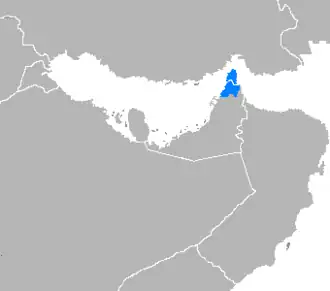Shihhi Arabic
| Shihhi Arabic | |
|---|---|
| Native to | United Arab Emirates, Oman |
| Speakers | 38,000 (2020)[1] |
Afro-Asiatic
| |
| Language codes | |
| ISO 639-3 | ssh |
| Glottolog | shih1239 |
 | |
Shihhi Arabic (Arabic: اللهجة الشحية, romanized: Al-Lahjah Al-Shihhiyya, also known as Shehhi, Khasabi, Musandam Arabic, or Ruʾus Al Jibal Arabic) is a dialect of Arabic primarily used in the Musandam Governorate of Oman and Ras Al Khaimah emirate of the United Arab Emirates.[1] It has been suggested that Shihhi Arabic has two main dialect groups, known as "inland" and "coastal".[2] The Shihuh, Habus, Al Dhuhoori and Al Shemaili tribes have traditionally used the dialect.
Phonology
Consonants
| Labial | Dental/Alveolar | Retroflex | Palatal | Velar | Uvular | Pharyngeal | Glottal | |||
|---|---|---|---|---|---|---|---|---|---|---|
| plain | emph. | |||||||||
| Nasal | m | n | ||||||||
| Stop/ Affricate |
voiceless | t | tˤ | (tʃ) | k | q | ʔ | |||
| voiced | b | d | dˤ | d͡ʒ | (ɡ) | |||||
| Fricative | voiceless | f | s | sˤ | ʃ | χ | ħ | h | ||
| voiced | z | ʁ | (ʕ) | |||||||
| Tap | ɻ ~ ɽ | |||||||||
| Approximant | l | (wˤ) | j | w | ||||||
- Sounds /ɡ, ʕ, tʃ/ are exclusively heard in loan-words.
- /ħ/ may be heard as a voiced glottal [ɦ] when before voiced consonants.
- The retroflex /ɻ/ may have four different allophones; as a flap [ɽ] when in intervocalic positions, as an alveolar [ɹ] when before front vowels, or as an alveolar tap or trill [ɾ, r] when in word-medial position following a consonant.[3]
- In some dialects *ġ has been replaced by a pharyngealized glottal stop [ʔˤ].[4]
Vowels
| Front | Back | |
|---|---|---|
| Close | i iː | u uː |
| Mid | eː | (o) oː |
| Open | a aː | |
| Phoneme/Sound | Allophones | Notes |
|---|---|---|
| /i/ [i] | [ɪ] | when in closed syllables |
| /a/ [æ] | [æ] | as the standard relisation, when in neutral environments or open syllables |
| [ɐ] | in closed syllables | |
| [a] | when occurring after a pharyngeal or glottal consonant | |
| [ɑ] | when within the vicinity of the velarized or pharyngealized, or uvular consonants | |
| /o/ [o] | [ɔ], [ʊ] | in free variation |
| /u/ [u] | [ʊ] | in free variation |
| [ɔ] | when preceded by a pharyngeal or velarized consonant | |
| /iː/ [iː] | [ɨː] | when preceded by /q/ |
| [iːᵊ] | offglide, when followed by a velarized/pharyngealized consonant | |
| [ᵊiː] | onglide, when preceded by a velarized/pharyngealized consonant | |
| /eː/ [eː] | [ɘː] | when preceded by /q/ |
| [ɪː] | when preceded by /b/ | |
| [iː] | when preceding or following /j/ | |
| [eːᵊ] | offglide, when followed by a velarized/pharyngealized consonant | |
| [ᵊeː] | onglide, when preceded by a velarized/pharyngealized consonant | |
| /aː/ [æː] | [æː] | when in neutral environments or open syllables |
| [aː] | when after a glottal stop /ʔ/ | |
| [ɑː] | within the position of a velarized/pharyngealized consonant or /ɻ/ consonant | |
| /oː/ [ɔː] | [ɔː] | as the standard realization |
| [oː] | when preceded be a labial, alveolar, or palatal consonant | |
| [ʊː] | when preceded by /ɻ/ | |
| /uː/ [uː] | [ʊː] | in free variation |
| [oː] | within the position of a velarized/pharyngealized consonant |
See also
Notes
- ^ a b Shihhi Arabic at Ethnologue (25th ed., 2022)

- ^ Shockley 2024
- ^ a b Bernabela, Roy S. (2011). A phonology and morphology sketch of the Šiħħi Arabic dialect of əlǦēdih (Oman). Leiden University.
- ^ Shockley, Mark. Ruʾūs al-Jibāl Arabic in Context: A Proposal for an Expanded Typology of Southeastern Arabian Dialects. Journal of Semitic Studies, Volume 69, Issue 1, Spring 2024, Pages 657, https://doi.org/10.1093/jss/fgad026
External links